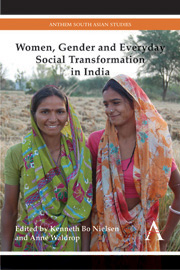Book contents
- Frontmatter
- Contents
- Acknowledgments
- Women and Gender in a Changing India
- PART I WORK, TECHNOLOGY, ASPIRATIONS
- PART II DEMOCRACY AND THE DEVELOPMENTAL STATE
- PART III ASSERTIONS AND ACTIVISM
- Chapter Eleven New Subalterns? Feminist Activism in an Era of Neoliberal Development
- Chapter Twelve Family, Femininity, Feminism: ‘Structures of Feeling’ in the Articulation of Men's Rights
- Chapter Thirteen Women's Activism in the Singur Movement, West Bengal
- Chapter Fourteen The Women's Question and Indian Maoism
- Chapter Fifteen Caste and Class in Gendered Religion: Dalit Women in Chennai's Slums
- About the Editors and Contributors
Chapter Thirteen - Women's Activism in the Singur Movement, West Bengal
from PART III - ASSERTIONS AND ACTIVISM
Published online by Cambridge University Press: 05 October 2014
- Frontmatter
- Contents
- Acknowledgments
- Women and Gender in a Changing India
- PART I WORK, TECHNOLOGY, ASPIRATIONS
- PART II DEMOCRACY AND THE DEVELOPMENTAL STATE
- PART III ASSERTIONS AND ACTIVISM
- Chapter Eleven New Subalterns? Feminist Activism in an Era of Neoliberal Development
- Chapter Twelve Family, Femininity, Feminism: ‘Structures of Feeling’ in the Articulation of Men's Rights
- Chapter Thirteen Women's Activism in the Singur Movement, West Bengal
- Chapter Fourteen The Women's Question and Indian Maoism
- Chapter Fifteen Caste and Class in Gendered Religion: Dalit Women in Chennai's Slums
- About the Editors and Contributors
Summary
In 2006 a number of villages in Singur in West Bengal's Hooghly district erupted in protest against the state government's decision to acquire 997 acres of agricultural land from the area. The land was to be handed over to Indian multinational Tata Motors, who planned to establish a car manufacturing unit in which they would produce the company's new Tata Nano, the world's most inexpensive car. During the many marches, rallies and demonstrations carried out by the Singur movement to signal its opposition to the land acquisition, local village women often led from the front, shouting slogans and confronting the police or government officials. The importance of women in the activities of the Singur movement was most forcefully brought to light when Tapasi Malik, a local teenage girl and movement activist, was made to pay with her life for her activism. Tapasi Malik was raped and burnt alive in December 2006, ostensibly by party loyalists belonging to the ruling Communist Party of India (Marxists) (CPI[M]), which was eager to see the Tata Motors project materialize swiftly and without any opposition.
In this chapter I use the case of the Singur movement to examine how social movement activism may serve as a vehicle for negotiating and transforming gender relations. Because the asymmetry in the relative positions of men and women in rural India both orders and pervades everyday social relations and practices, social movements are inherently gendered (Sinha Roy 2006). The questions I explore here are: Why and how did women come out in support of the Singur movement? What did being an activist entail? How did they conceive of and explain their activism? And, crucially, to what extent can their activism be seen to have lead to broader gender transformations? I begin below by locating the discussion in the broader discourse on gender and politics in India, including an examination of an emerging body of ethnographically informed literature on the topic, on which I draw extensively in the analysis that follows. After briefly outlining the trajectory and scope of the Singur movement, I proceed to analyse women’s participation in it.
- Type
- Chapter
- Information
- Women, Gender and Everyday Social Transformation in IndiaA Revisionary History, pp. 203 - 218Publisher: Anthem PressPrint publication year: 2014



